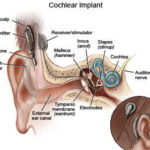COCHLEAR IMPLANT
Description
A cochlear implant (CI) is a surgically implanted electronic device that provides a sense of sound to a person who is profoundly deaf or severely hard of hearing in both ears; as of 2014 they had been used experimentally in some people who had acquired deafness in one ear after learning how to speak. Cochlear implants bypass the normal hearing process; they have a microphone and some electronics that reside outside the skin, generally behind the ear, which transmits a signal to an array of electrodes placed in the cochlea, which stimulate the cochlear nerve.
The procedure in which the device is implanted is usually done under general anesthesia. Risks of the procedures include mastoiditis, otitis media (acute or with effusion), shifting of the implanted device requiring a second procedure, damage to the facial nerve, damage to the chorda tympani, and wound infections. People may experience problems with dizziness and balance for up to a few months after the procedure; these problems generally resolve, but for people over 70, they tend not to.
There is low to moderate quality evidence that when CIs are implanted in both ears at the same time, they improve hearing in noisy places for people with severe loss of hearing. Implanting the CIs sequentially instead of simultaneously makes things worse or causes no change. There is some evidence that implanting CIs to improve hearing, may also improve tinnitus but there is some risk that it may cause people who never had tinnitus to get it.
There is controversy around the devices; much of the strongest objection to cochlear implants has come from the Deaf community. For some in the deaf community, cochlear implants are an affront to their culture, which as they view it, is a minority threatened by the hearing majority

